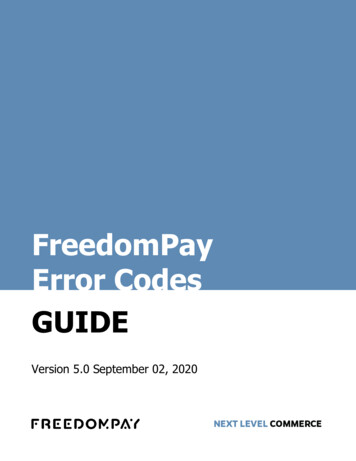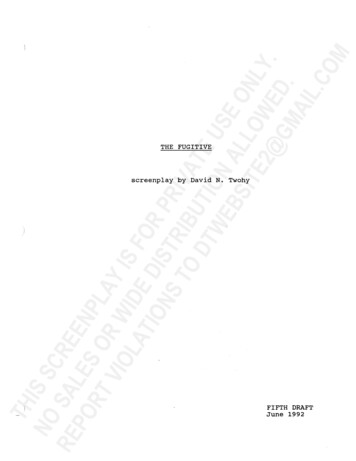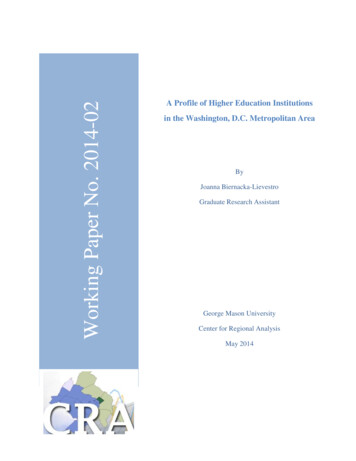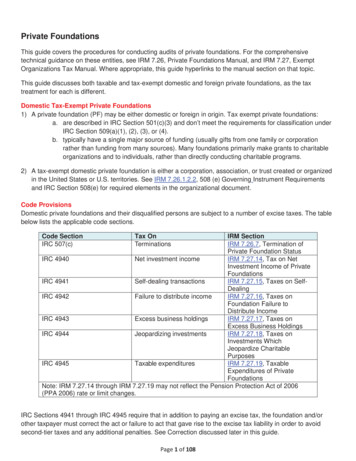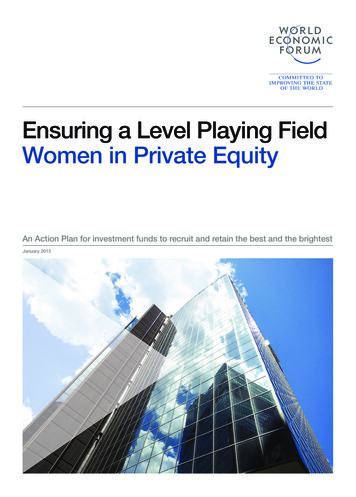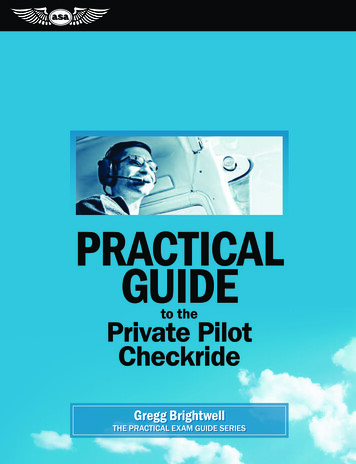
Transcription
PRACTICALGUIDEto thePrivate PilotCheckrideGregg BrightwellTHE PRACTICAL EXAM GUIDE SERIES
THE PRACTICAL EXAM GUIDE SERIESPractical Guide to the Private Pilot CheckrideStudy guide for the ground portion of the FAA Practical ExamGregg BrightwellAviation Supplies & Academics, Inc.7005 132nd Place SE Newcastle, WA 98059asa@asa2fly.com www.asa2fly.com 2014 Aviation Supplies & Academics, Inc.All rights reserved.Cover photo: Shutterstock, Stacey NewmanPrinted in the United States of 1ASA-PRACT-PVTISBN 978-1-61954-195-5Library of Congress Cataloging-in-Publication DataBrightwell, Gregg, author.Practical guide to the private pilot checkride / Gregg Brightwell.pages cm – (Practical exam guide series)“Study guide for the ground portion of the FAA Practical Exam “ – Title page verso.ISBN 978-1-61954-195-5 (trade paper) – ISBN 1-61954-195-5 (trade paper)1. Airplanes—Piloting—Examinations—Study guides. 2. Airplanes—Piloting—Handbooks, manuals, etc. 3. Private flying—United States—Examinations, questions,etc. 4. United States. Federal Aviation Administration—Examinations. I. Title.TL710.B64 2014629.132’5217076—dc23201403174802
ContentsForeword. . . . . . . . . . . . . . . . . . . . . . . . . . . . . . . . . . . . . . . . . . . . . . . . . . . . . . . . . . . . . . . . vAcknowledgments. . . . . . . . . . . . . . . . . . . . . . . . . . . . . . . . . . . . . . . . . . . . . . . . . . . . viAbout the Author. . . . . . . . . . . . . . . . . . . . . . . . . . . . . . . . . . . . . . . . . . . . . . . . . . . . . . viIntroduction. . . . . . . . . . . . . . . . . . . . . . . . . . . . . . . . . . . . . . . . . . . . . . . . . . . . . . . . . . . viiPractical Test Essentials. . . . . . . . . . . . . . . . . . . . . . . . . . . . . . . . . . . . . . . . . . . . . . 1Prerequisites for the Private Pilot CertificateAircraft and Equipment Required for the Practical TestSpecial Emphasis AreasApplying the PTS Objectives and TasksArea of Operation I: Preflight Preparation. . . . . . . . . . . . . . . . . . . . . . . . . . . 7Area of Operation II: Preflight Procedures. . . . . . . . . . . . . . . . . . . . . . . . . 29Area of Operation III: Airport and Seaplane Base Operations. . . 41A Note About the Flight Portion of the Test. . . . . . . . . . . . . . . . . . . . . . . . 49Test Day: Taking the Practical Test. . . . . . . . . . . . . . . . . . . . . . . . . . . . . . . . . 57Appendix: FAA-S-8081-14B. . . . . . . . . . . . . . . . . . . . . . . . . . . . . . . . . . . . . . . . . 63Private Pilot Practical Test Standards for Airplane Single-Engine Land and Seaiii
Forewordby Nan GaylordI first met Gregg when he was a student in my CFI Practical and Exam PrepCourse in February 2009. I immediately recognized his spirit of excellenceand demand for the pursuit of perfection. I love those traits in a person— andespecially in my flight instructors and pilots! His lesson plans were the best I hadever seen in my 41 years as a CFI and 25 years as a DPE (having administeredmore than 1,000 CFI Initial Practical Exams for the OKC FSDO). I have sinceused them as examples for the other students. When he told me he was going toput them in a book made available to CFI wannabes and people preparing for themother of all checkrides—the CFI initial exam—I was thrilled.It has been over a year now since the release of Gregg’s first book—thePractical Guide to the CFI Checkride. I have recommended the book to all of mystudents taking my CFI class, for their use in helping to prepare for their practicalexam. It has been a huge success with them and their results on the exams.So I am very excited that Gregg is now offering the same type of guidanceto prepare for the Private Pilot Practical Exam! Whether you are getting yourprivate pilot certificate for the luxury of “fun flying,” or perhaps transportation,or beginning the first step in a new career, it is vitally important that you learnthings correctly the first time—in aviation we call this “the Law of Primacy.” Ibelieve this book will give you the guidance to do that.There is no mystery to passing the Private Pilot Practical Exam on the firstattempt if you follow Gregg’s carefully laid out directions; the entire groundportion of the exam is here—the outcome will be determined by your preparation. I strongly endorse this book and think it will greatly assist you in preparingfor the ground portion of the Private Pilot Practical Exam.Good Luck and Tailwinds,NanNan is an ATP/SEL&MEL, Gold Seal And Master CFI/CFII/MEI, MasterGround Instructor/GIA&I. With over 10,000 hours, she has administered over7,000 practical exams including over 1,000 CFI initial practical exams.v
AcknowledgmentsThroughout this book, I reference many sources and most are textual referencesfrom the FAA. Yet perhaps the most important reference source for this bookis the knowledge and experience I acquired from Nanette Gaylord, CFI in theTulsa, Oklahoma area. Her expertise has greatly benefited my CFI studies. Withher help, I was very well prepared for my CFI practical exam with the FSDO inOklahoma City, and scored high praise from the administering inspector.About the AuthorGregg Brightwell holds a B.S. in Aviation Science, CFI(I)/MEI, AGI, ATP, andA&P certificates, and has worked for Cessna Aircraft Company as an Experimental Flight Mechanic, Production Flight Test Pilot, and Avionics Technician;currently he is a Flight Test Engineer at Bombardier Learjet. He is passionateabout aviation and loves the freedom flying offers, as well as sharing this withhis students.viPractical Guide to the Private Pilot Checkride
IntroductionThe intent of this book is to consider the vast amount of information thataspiring pilots must learn and find ways to help simplify this task by organizingand managing it. There are dozens of FAA Advisory Circulars (ACs), officialFAA manuals, and other instructional books out there that go into great detailteaching what there is to know about all things pertaining to aviation. So PrivatePilot applicants read, and read, and then read some more.Preparing for the Private Pilot practical exam is hard. It takes a lot of dedication, very disciplined studying, and can be a significant expense. Then, afterall of that, you ask yourself, “What is the examiner looking for?” Speaking of“examiner,” let’s clarify that term. On practical exams for other certificates orratings, applicants can choose either a Designated Pilot Examiner (DPE) or anFAA Aviation Safety Inspector in operations. So from here forward, the termsexaminer and inspector will be used interchangeably.Back to what the examiner is looking for: as with other certificates andratings, the Private Pilot applicant will be tested using the appropriate FAAPractical Test Standards (PTS). These standards cover the expectations, andtolerances that must be met to earn the Private Pilot Certificate. Therefore, as youbegin to prepare for your practical test, where do you start? How do you organizeand prioritize all this information? How do you correlate the Practical TestStandards to what you’ve learned in your studies? What specifically do you needto know to demonstrate mastery of a given subject? How do the “Area of Operations” and “Tasks” translate to questions you can expect examiners to ask?These are the questions this book is designed to answer—it can serve as aplain-language study guide to help you navigate through all those thousands ofpages of material. This book can help you organize that material and correlateit to the FAA’s training and testing document by clarifying wherever the PTS isvague about source materials.A note: this book does not include discussions on the Areas of OperationIV–XII, which is the flight portion of the practical exam—these were intentionally omitted. The examiners and inspectors I queried agreed that applicants whovii
do well on the ground portion of the exam typically do well on the flight portion.Applicants generally spend enough time rehearsing and preparing for the flightportion, yet they underestimate the significance of the ground portion.Areas of Operation are phases of the practical test arranged in a logicalsequence within each standard. They begin with Preflight Preparation and endwith Postflight Procedures. The examiner may conduct the practical test in anysequence that will result in a complete and efficient test. However, the groundportion of the test will be conducted before the flight portion.So, let’s get started: Use this book as a guide to help you prepare for theground portion of the practical test. With all this preparation, you’ll be better ableto pull the pertinent knowledge from the original sources. There is a lot to learn,but you can do it! Are you ready to become a licensed private pilot?viiiPractical Guide to the Private Pilot Checkride
Practical Test EssentialsPrerequisites for the Private Pilot CertificateFor the sake of discussion in this book, the assumption will be that you areapplying for your Private Pilot certificate, in a single-engine land airplane.What are the prerequisites to becoming a Private Pilot? The answer is inTitle 14 of the Code of Federal Regulations (14 CFR) Part 61. So, let’s take a lookat the current FAR/AIM (Federal Aviation Regulations/Aeronautical InformationManual), at §61.103—Eligibility Requirements. To be eligible to take the PrivatePilot Practical Test, an applicant must:1. Be at least 17 years of age.2. Be able to read, speak, write, and understand the English language. If thereis a doubt, use Advisory Circular (AC) 60-28, English Language SkillStandards.3. Have passed the appropriate private pilot knowledge test since the beginningof the 24th month before the month in which he or she takes the practicaltest. Or, more simply put, you have 2 years from the last day of the monthin which you took the knowledge exam, to take and pass the practical test.After that date, the test will expire, and must be retaken.4. Have satisfactorily accomplished the required training and obtained the aeronautical experience prescribed;5. Possess at least a current third class medical certificate. Also, if you are amilitary pilot of the U.S. Armed Forces, you can show and present evidenceof an up-to-date medical examination authorizing pilot status issued by theU.S. Armed Forces;6. Have an endorsement from an authorized instructor certifying that the applicant has received and logged training time within two (2) calendar monthspreceding the date of application in preparation for the practical test, and isprepared for the practical test;1
7. Receive and log ground training from an authorized instructor or complete ahome-study course on the aeronautical knowledge areas of 14 CFR §61.105paragraph (b) that apply to the aircraft category and class rating sought; and8. Also have an endorsement certifying that the applicant has demonstratedsatisfactory knowledge of the subject areas in which the applicant wasdeficient on the airman knowledge test (not required for power aircraft tonon-power aircraft or power aircraft to power aircraft for additional categoryor class rating).Aircraft and Equipment Required for thePractical TestThe private pilot—airplane applicant is required by 14 CFR §61.45 to providean airworthy, certificated aircraft for use during the practical test. This sectionfurther requires that the aircraft must:1. Be of U.S., foreign, or military registry of the same category, class, andtype, if applicable, for the certificate and/or rating for which the applicant isapplying;2. Have fully functioning dual controls, except as provided for in 14 CFR§61.45(c) and (e); and3. Be capable of performing all Areas of Operation appropriate to the ratingsought and have no operating limitations, which prohibit its use in any of theAreas of Operation, required for the practical test.Special Emphasis AreasThe Private Pilot PTS lists 16 “special emphasis areas.” While not part of aparticular PTS “Task,” or element of a Task, the FAA considers these specialareas essential to flight safety. During your practical test, you will be evaluatedon them constantly—often without you even knowing about it. For example,there isn’t a specific Task for “positive aircraft control,” but rest assured thatyou are being evaluated, during the entire practical test and for every Task, onpositive aircraft control.So each of the following 16 areas will be evaluated in this way, throughoutthe practical test:1. Positive aircraft control.2. Positive exchange of the flight controls procedure.3. Stall/spin awareness.4. Collision avoidance.5. Wake turbulence avoidance.6. LAHSO.2Practical Guide to the Private Pilot Checkride
7.8.9.10.11.12.13.14.15.16.Runway incursion avoidance.CFIT.ADM and risk management.Wire strike avoidance.Checklist usage.Temporary flight restrictions (TFRs).Special use airspace (SUA).Aviation security.Single-Pilot Resource Management (SRM).Other areas deemed appropriate to any phase of the practical test.Single-Pilot Resource Management (SRM)The FAA defines SRM as “the art and science of managing all the resources(both onboard the aircraft and from outside sources) available to a single pilot(prior to and during flight) to ensure that the successful outcome of the flight isnever in doubt.” In more practical terms it means to use all available resources,from preflight to postflight, to set yourself up for success.The following six items are areas of SRM, as listed in the PTS:1. Aeronautical decision making (ADM)2. Risk management3. Task management4. Situational awareness5. Controlled flight into terrain (CFIT) awareness6. Automation managementAll six of these areas are covered at length in the various ground school textbooks and in the Private Pilot PTS (reminder: the PTS is included as an appendixat the end of this book). Each area is important and worth a separate discussionhere; below is a brief explanation of each area of SRM.Aeronautical Decision Making (ADM)Sound ADM is learned over time, not overnight. However, common sense anda realistic assessment of your piloting abilities go a long way toward settingyourself up for success. Don’t put yourself in a position where the airplane, environment, weather, or controller can get the best of you. Just because a 3,000-footceiling and 5 miles visibility constitutes VFR doesn’t necessarily mean that theweather is “good enough” for the trip you are taking. Even if you set yourselfup perfectly for a proper traffic pattern entry, it’s wasted effort if you jammedyourself into that pattern with 10 other aircraft. Some good advice for developinggood ADM is “Look Ahead, Plan Ahead.” Anticipate the obstacles that you mayencounter in the next phase of your flight.Practical Test Essentials3
Risk ManagementRisk is defined as the probability and possible severity of accident or loss fromexposure to various hazards, including injury to people and loss of resources.So how do we manage risk? We must determine the risks, the type and level.After the level of risk has been determined, actions can be taken to mitigate thatrisk. For example, a non-instrument pilot with marginal weather planned for hisflight can reduce the risks of MVFR by waiting for weather to improve, takingalong an instrument-rated pilot, delaying or canceling the trip, or just by drivinginstead. The following are three tools and/or checklists commonly employed inmanaging risk:The PAVE Checklist Pilot-in-command—Is the pilot ready for the trip? Reference the IMSAFEchecklist below. Aircraft—Is the aircraft and its equipment familiar to the pilot and ready/suitable for the trip? EnVironment—Weather, terrain, airspace, airports and day/night are allfactors to consider. External pressures—“Get-there-itis” or adhering to the schedule no matterwhat, a desire to impress, etc.; is this affecting the flight?IMSAFE Checklist (These questions focus especially on you, the pilot.) Illness—Any symptoms? Medication—Have I been taking prescription or over-the-counter drugs? Stress—Am I worried about health, money, family, or having trouble atwork? Alcohol—Have I been drinking in the last 8 hours? 24 hours? Fatigue—Am I tired, and not well-rested? Eating—Am I adequately nourished?5P Model (Note: this is a practical application of SRM.) The Plan—The mission or task. Dynamic, the plan can change as situationschange. The Plane—Are the airplane and its systems suitable for the mission? The Pilot—Reference the IMSAFE checklist, assess and mitigate risks tomake operation safer. The Passengers—Accommodate, but do not sacrifice personal minimums tocomplete mission. The Programming—The pilot must be familiar with the onboard equipmentin the airplane. Programming flight plans, approaches, and route changestake time and attention. Make certain that the pilot can program the equipment and at the same time, stay ahead of the airplane.4Practical Guide to the Private Pilot Checkride
Task ManagementTask management refers to the process by which pilots manage the many concurrent tasks that must be performed to safely and efficiently fly a modern aircraft.These tasks are performed by humans, not by machines. It is up to the pilot toprioritize the necessary tasks for the flight. The pilot must constantly monitorthe task load and allocate resources (both human and machine) to complete thesetasks. It is vitally important to remember that humans have a limited capacity.Failure to employ proper task management can lead to task saturation.Situational AwarenessSituational awareness (SA) means knowing every element of where the aircraft isin regard to location, air traffic control, weather, regulations, aircraft status, andother factors that may affect safety before, during and after the flight. To keepSA in check, pilots must take a proactive approach, and stay ahead of the aircraft.In other words, you must know what is supposed to happen next, and how youare supposed to respond.Controlled Flight into Terrain (CFIT) AwarenessCFIT awareness is vitally important; during your flight planning, take note ofany obstacle and terrain hazards along the route, and avoid them along the routeif possible. Using the proper and current charts is absolutely necessary, as well asknowing the limitations of the aircraft. Always have a Plan B, and be preparedto divert as necessary. Lastly, use all available resources; TAWS, GPWS (ifequipped), and VFR sectionals (topographic) are excellent ones.Automation ManagementAutomation management is the demonstrated ability to control and navigate anaircraft by means of the automated systems installed in the aircraft. Modernaircraft can be very well equipped, with high levels of automation. It is criticalthat you always know the status and current mode of your autopilot or FMS, andwhat the next anticipated mode will be. If the autopilot or FMS is not operating properly, for whatever reason, you must recognize this and either correctthe issue or disengage the automation as necessary. The automation is there toreduce workload, not add to it.Applying the PTS Objectives and TasksWhat we have discussed so far is what it takes just to be eligible to take the practical test. Next, we will cover what you should study in order to prepare for it.Just like in all the Practical Test Standards, the Private Pilot PTS is broken downinto “Areas of Operation” (AOs), “Tasks,” and “Elements” within those Tasks.Our objective, then, is to further break down each of these elements into a practical application. To begin that process, the next section will begin with “Area ofOperation I, Preflight PreparationIn this text you will find many, many acronyms—and detailed explanationswill follow those acronyms. But don’t expect the examiner to be impressed justPractical Test Essentials5
because you can memorize complicated textbook answers. It is called a “practical test” for a reason: you must demonstrate proficiency and knowledge, whichrequires a much deeper understanding than mere memorization. The examinerwill quiz you using mostly situational and “what if?” scenario-based questions.This is the reason for working to practically apply the PTS objectives—so youcan answer the examiner’s often “real-world” or scenario-based questioning.The Private Pilot practical test is largely about preparation. Adequate preparation will be rewarded with a temporary pilot certificate. Inadequate preparationwill be rewarded with an invitation to come back and try again.Note: Specific aircraft information listed within this book is for a Cessna 172,which is highly representative of the typical general aviation training fleet.6Practical Guide to the Private Pilot Checkride
Area of Operation I:Preflight PreparationTask A: Certificates and DocumentsTask B: Airworthiness RequirementsTask C: Weather InformationTask D: Cross-Country Flight PlanningTask E: National Airspace SystemTask F: Performance and LimitationsTask G: Operation of SystemsTask H: Water and Seaplane CharacteristicsTask I: S eaplane BASES, Maritime Rules, and Aids to Marine NavigationTask J: Aeromedical Factors
NOTESTask A: Certificates and DocumentsReferences: 14 CFR §§61.103–61.117, 61.113.As a Private Pilot applicant, you must exhibit satisfactory knowledge of theelements related to certificates and documents by:1. Explaining—a. private pilot certificate privileges, limitations, and recentflight experience requirements.Recent pilot flight experience requirements: To act as PIC: 14 CFR §61.56, §61.57 Flight review within preceding 24 months (new certificate or ratingtakes the place of flight review). To carry passengers, day: 3 takeoffs/landings within preceding 90days (can be touch-and-go’s). To carry passengers, night: 3 takeoffs/landings within last 90 days(must be full stop). Night takeoffs and landings must be logged 1 hour after sunset to 1hour before sunrise.Private pilots—privileges and limitations, §61.113: may not fly for hire or for compensation. may not pay less than pro rata share for the flight. may act as PIC of a flight for a charitable event, within the guidelinesof 14 CFR §91.146.b. medical certificate class and duration.First class medical: For ATP privileges, good for 12 months under age 40, 6 months overage 40. Thereafter, reverts to 2nd class privileges until the end of the 24thmonth after issuance (any age). Can operate with 3rd class privileges until the end of the 60th monthafter issuance (under 40).Second class medical: For commercial operations, good for 12 months (any age). Thereafter, reverts to 3rd class privileges until the end of the 24thmonth after issuance if over 40. Can operate with 3rd class privileges until the end of the 60th monthafter issuance if under age 40.Third class medical: Good for 60 months under age 40, 24 months for over age 40.Area of Operation I: Preflight Preparation9
NOTESc. pilot logbook or flight records.The only information required to be entered into a pilot’s logbook isthat which is required for a certificate, rating, recency, or flight review.However, pilots should also log date, flight time, departure and arrivallocation, type of flight (solo, PIC, flight/ground training given), andconditions of flight (VFR, IFR, etc.).2. Locating and explaining—Remember the acronym AROW.NOTE: If any of the four items below are NOT onboard the aircraft,then you are not legal to fly—the aircraft is rendered unairworthy.a. airworthiness and registration certificates.Airworthiness certificate—Like the name implies, an airworthinesscertificate is issued to an aircraft after an FAA representative hasinspected the aircraft and found it to meet the requirements of 14 CFRPart 21. It must be displayed and legible for passengers and crew.Registration—The aircraft must carry a Certificate of Registration. Thiscertificate shows that the aircraft is registered with the FAA AircraftRegistry, and identifies the current owner and registration (“N” number)of the aircraft.Both the Airworthiness and Registration Certificates are typicallylocated near the pilot’s leg, on the lower sidewall of the aircraft.b. operating limitations, placards, instrument markings, andPOH/AFM.Operating limitations—The operating limitations, placards, and instrument markings are all typically found in the aircraft POH (pilot’soperating handbook) or AFM (airplane flight manual). The POH iscommon for a particular aircraft make/model, but the AFM is specific toa particular “N” number.c. weight and balance data and equipment list.Weight and balance data includes items such as basic empty weight,gross weight, and center-of-gravity (CG) computations. There are chartsand graphs that help you determine how much weight you can carry (i.e.,fuel vs. passengers), and where to put it to make sure that your CG is ina suitable range. This data is usually placed in the aircraft POH/AFM forreference.10Practical Guide to the Private Pilot Checkride
Private Pilot Practical Test Standards for Airplane Single-Engine Land and Sea. v Foreword by Nan Gaylord I first met Gregg when he was a student in my CFI Practical and Exam Prep Course in February 2009. I immediately recognized his spirit of excellence and demand for the p


